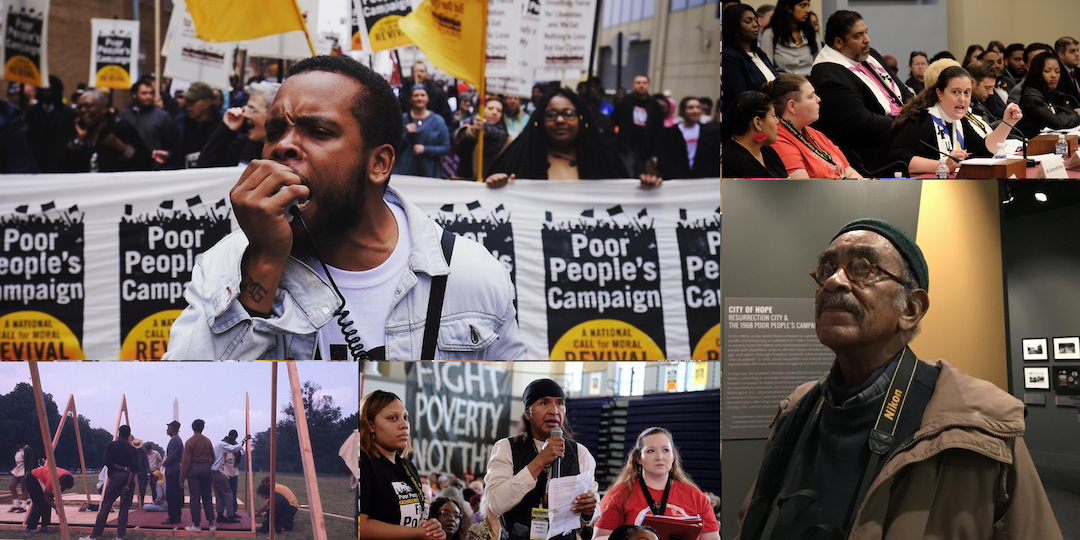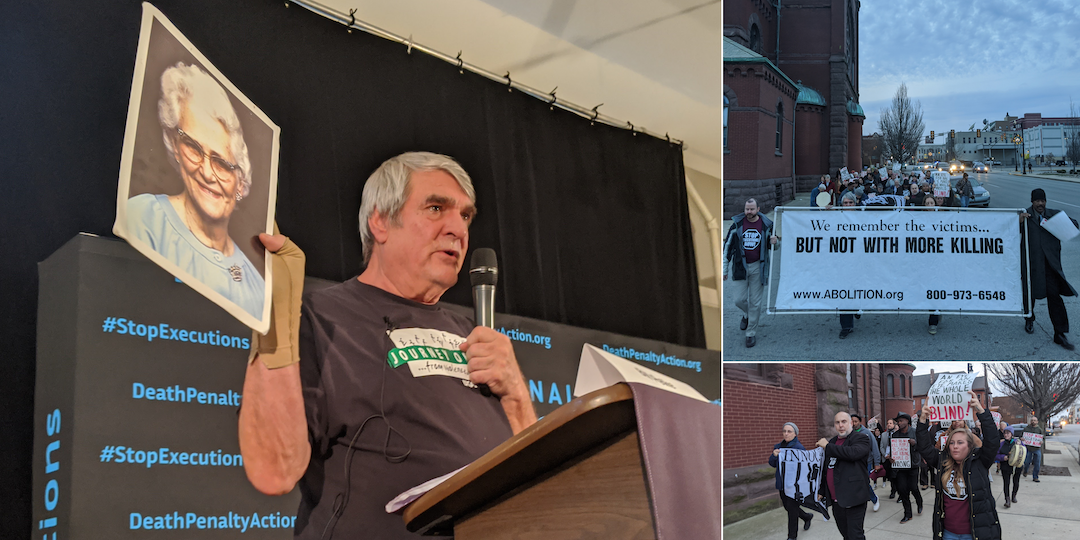Narrative Shift: From The War on Poverty to “Ending Welfare as We Know It”

The conversation about the War on Poverty, welfare, and other public assistance programs has reflected a series of narrative shifts. This case study describes how this conversation evolved over a period of three decades, from 1964 to 1996—from a time when the federal government’s intervention in the economic life of the country to create more opportunity for those on the bottom rung was seen as a positive good, to a time when such a role for government was seen as counterproductive and even harmful. It tells the story of how a relatively small conservative movement was able to harness the power and resources of major corporations to fund think tanks and foundations that would produce the intellectual capital to attack the liberal War on Poverty and Great Society of the Johnson years, how the mass media would carry this new conservative narrative, and how the dog-whistle rhetoric of Ronald Reagan would reinforce and reify it.
METHODOLOGY
Our research methodology included in-depth interviews with key stakeholders, a comprehensive literature review, and traditional and social media research.
INTERVIEWEES:
- Frances Fox Piven, PhD, Distinguished Professor Emeritus at the Graduate Center of the City University of New York and author of Poor People’s Movements: Why They Succeed, How They Fail, Vintage Books, 1979
- Martin Gilens, PhD, Professor of Public Policy, UCLA, and author of Why Americans Hate Welfare, University of Chicago Press, 2009
- Rebecca Vallas, Senior Fellow, Center for American Progress
- Lee Cokorinos, Director of Democracy Strategies and author of Upsizing Democracy: Confronting the Right Wing Assault on Government, 2007
OTHER SOURCES CONSULTED:
- Marisa Chappell, The War on Welfare: Family, Poverty, and Politics in Modern America. University of Pennsylvania Press, 2010.
- Martin Gilens, Why Americans Hate Welfare: Race, Media, and the Politics of Anti-Poverty Studies. University of Chicago Press, 1999.
- Michael B. Katz, The Undeserving Poor: America’s Enduring Confrontation With Poverty. Oxford University Press, 2013.
- Charles Murray, Losing Ground: American Social Policy, 1950–1980. Basic Books, 1984.
- Annelise Orleck and Lisa Gayle Hazirjian, Eds., The War on Poverty: A New Grassroots History, 1964–1980. University of Georgia Press, 2011.
- Jean Stefancic and Richard Delgado, No Mercy: How Conservative Think Tanks and Foundations Changed America’s Social Agenda. Temple University Press, 1996.
- George Gilder, Wealth and Poverty. Basic Books, 1981.
- Lawrence Mead, Beyond Entitlement: The Social Obligations of Citizenship. Free Press, 1986.
Based on a series of historical benchmarks, we identified three time periods and their external (i.e., events beyond the control of the advocates) and field-wide (or internal) tipping points that comprised the stages of narrative shift:
EARLY YEARS: THE GREAT SOCIETY, 1964–1970
EXTERNAL TIPPING POINTS
- President Johnson declares a War on Poverty and makes his “Great Society” speech.
- The Civil Rights Act and Voting Rights Act are passed and signed into law.
- The Equal Opportunity Act and Community Action Program are passed and signed into law.
- The Supreme Court upholds the rights of welfare recipients.
INTERNAL TIPPING POINTS
- The National Welfare Rights Organization is founded.
- Martin Luther King, Jr. launches the Poor People’s Campaign.
- Rights of welfare recipients begin to be established through litigation.
- The concept of “community control” takes root.
MIDDLE YEARS: THE RISE OF THE CONSERVATIVE NARRATIVE, 1970–1990
EXTERNAL TIPPING POINTS
- Economic recession and cutbacks take place.
- Urban uprisings begin to occur.
- Increasingly negative media coverage of welfare fraud, “dysfunctional black family,” and crime is seen.
- Ronald Reagan is elected, and the Omnibus Budget Reconciliation Act is passed.
INTERNAL TIPPING POINTS
- The Heritage Foundation, Cato Institute, and Americans for Tax Reform are founded.
- Losing Ground by Charles Murray and Beyond Entitlement by Lawrence Mead are published.
- The terms “the underclass,” “culture of poverty,” and “black family dysfunction” emerge.
- Reagan launches his attacks on “welfare queens,” “welfare chiselers,” and “poverty pimps.”
LATER YEARS: “ENDING WELFARE AS WE KNOW IT,” 1990–1996
EXTERNAL TIPPING POINTS
- Clinton makes the campaign promise to “end welfare as we know it.”
- Republicans sweep Congress in 1994 midterm elections.
- The Personal Responsibility and Work Opportunity Reconciliation Act passes.
INTERNAL TIPPING POINTS
- Gingrich’s Contract with America introduces the Personal Responsibility Act.
- Religious right’s influence grows with “family values.”
THE WAR ON POVERTY
On January 8, 1964, in his first State of the Union Address, Lyndon Johnson declared an “unconditional war on poverty in America.” Describing his declaration as a continuation of the Kennedy legacy, he told the nation, “The program I shall propose will emphasize this cooperative approach [between federal, state, and local efforts] to help that one-fifth of all American families with incomes too small to even meet their basic needs…. Our aim is not only to relieve the symptoms of poverty, but to cure it, and above all, to prevent it.” Several months later, Johnson gave his “Great Society” speech at the University of Michigan’s commencement exercises in which he called upon the graduating students to “join the battle to give every citizen the full equality which God enjoins and the law requires, whatever his belief, or race, or the color of his skin” and to “join the battle to give every citizen an escape from the crushing weight of poverty.”
The “War on Poverty” was both a set of social policies and at the very core a narrative about the role of government in alleviating the effects of severe economic inequality. The Economic Opportunity Act (EOA), passed by Congress in August 1964, poured $947 million into anti-poverty programs. The four main policies enacted under the banner of the “war” were breathtaking in scope:
- The Social Security Amendments of 1965, which created Medicare and Medicaid and also expanded Social Security benefits for retirees, widows, people with disabilities, and college-aged students.
- The Food Stamp Act of 1964.
- The Economic Opportunity Act of 1964, which established the Job Corps, the VISTA program, and the federal work-study program. It also established the Office of Economic Opportunity (OEO), the arm of the White House responsible for implementing the war on poverty and that created the Head Start and Legal Services for the Poor programs in the process.
- The Elementary and Secondary Education Act of 1965, which subsidized school districts with a large share of impoverished students.
It’s important to note that the cash assistance program, otherwise known as “welfare,” had already been established in 1935 as the Aid to Families with Dependent Children (AFDC) program as one of the signature achievements of the New Deal.
Along with the Civil Rights Act of 1964 and later the Voting Rights Act of 1965, the War on Poverty manifested the positive role the federal government could, and should, play in addressing injustice and inequality. The aspirational narrative that propelled the War on Poverty was contained in the introduction to the Equal Opportunity Act:

It is the policy of the United States to eliminate the paradox of poverty in midst of plenty in this nation by opening, to everyone, the opportunity for education and training, the opportunity to work, and the opportunity to live in decency and dignity.
Its soaring rhetoric emphasized the values of compassion, empowerment, and entitlement. It helped that in 1962 a book was published that had a profound impact on how the American public viewed poverty. This was The Other America by Michael Harrington, in which he revealed that 25 percent of the nation was destitute and “for reasons beyond their control, cannot help themselves.” The book was a publishing phenomenon; Time magazine named it one of the 10 most influential books of the twentieth century and it sold millions of copies. That such hidden suffering existed in the midst of the country’s post-war prosperity stirred the conscience of America. The successes of the New Deal, especially Social Security, were still fresh in voters’ minds, and a proactive role for the federal government in ameliorating social and economic problems was relatively uncontroversial.
The War on Poverty unleashed a wave of grassroots organizing and activism.[1] The OEO itself called for “maximum feasible participation” by the poor, and the Community Action Program (CAP) was adopted by Congress to funnel resources into local anti-poverty programs nationwide. In submitting the bill to Congress, President Johnson stated:
[THE CAP] asks men and women throughout the country to prepare long-range plans for the attack on poverty in their own local communities…. [T]hese plans will be local plans calling upon all the resources available to the community—Federal and State, local and private, human and material.
“Community control” became a watchword, and men and women living on the margins of society began to assert their rights. Women in particular were galvanized and advocated for better food, schools, and healthcare for their children. In 1966 the National Welfare Rights Organization (NWRO) brought more than 50 local welfare rights groups under one umbrella; at its peak the NWRO had 25,000 mostly African American poor women as members. It engaged in legislative lobbying and public protest. In 1970 the welfare rights movement scored a major victory when the U.S. Supreme Court ruled in the case of Goldberg v. Kelly that welfare benefits were “entitlements” in which recipients had a “property interest” that could not be abrogated without a hearing and other due process rights. In his majority opinion, Justice William Brennan echoed the fundamental premise and narrative of the War on Poverty:
“From its founding the Nation’s basic commitment has been to foster the dignity and well-being of all persons within its borders. We have come to recognize that forces not within the control of the poor contribute to their poverty. This perception, against the background of our traditions, has significantly influenced the development of the contemporary public assistance system.”
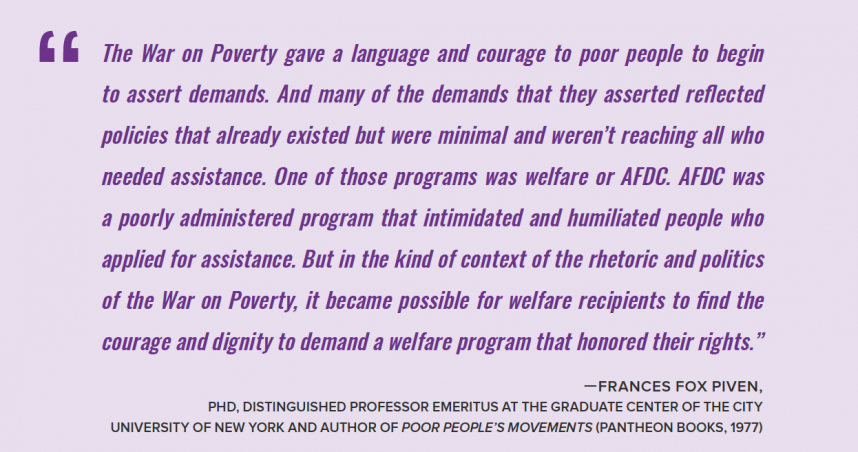
Many of the War on Poverty’s early programs are still functioning today and are considered fixtures of the nation’s social safety net. They include Medicaid and Medicare; Legal Services for the Poor; Head Start; the Special Supplemental Nutrition Program for Women, Infants, and Children (WIC); and Job Corps. Nevertheless, in today’s public discourse, the War on Drugs is considered a failure, or, as President Ronald Reagan put it, “The federal government declared war on poverty, and poverty won.” This case study describes, in broad strokes, the narrative shift that took place between President Johnson’s declaration of war and President Clinton’s promise to “end welfare as we know it.”
A TUMULTUOUS DECADE
The War on Poverty was launched on the eve of a tumultuous decade. At the same time the massive federal poverty program was being developed and implemented, the country was entering a period of sustained economic decline. It is also important to note that the coinciding war in Vietnam contributed to the shaping of perceptions and policies around the War on Poverty, particularly how returning soldiers were treated and the ongoing movements for civil rights and justice. For the millions of African Americans who migrated out of the Jim Crow South and moved into poor urban neighborhoods in the north and west of the country, the collapse of manufacturing and heavy industry in those areas meant living lives of extreme poverty. Frustration with police misconduct, joblessness, and the slow pace of change sparked urban uprisings in poor black communities across the country. According to the Kerner Commission report issued in February 1968,[2] there were more than 150 “urban riots” between 1964 and 1968.
Media coverage of conflagrations in Newark, Detroit, Watts (neighborhood of Los Angeles), and other cities carried images of African Americans looting stores and burning buildings in their own “ghetto” neighborhoods.[3] While the nonviolent Civil Rights Movement in the South garnered support from a majority of Americans—a Gallup poll taken in 1964 showed that the public approved of the Civil Rights Act by nearly two-to-one—many, if not most white Americans viewed the “ghetto riots” with fear and disapproval. Poverty became more and more associated not with widows and orphans or Appalachia, but with black city dwellers. This association was reinforced by the mass media all through the late-1960s and ’70s.
Martin Gilens, a political scientist at Princeton University, studied decades of media coverage for his book Why Americans Hate Welfare.[4] He found that up until the end of 1964, accounts of the War on Poverty were generally positive and were mostly illustrated with images of poor white people. He explains:
Starting around 1965, the discourse about the War on Poverty became much more negative, and that was for a few reasons, one of them being that programs that the administration had been promoting were now out in the field, and people, especially conservatives, were starting to take aim at them. And the media started to portray those programs much more negatively as being abused by people who didn’t really need them, as being inefficient and so on. And it’s really right at that time—and it’s a very dramatic shift in the media portrayal—that the imagery shifts from poor white people, positively portrayed, to poor black people, negatively portrayed.
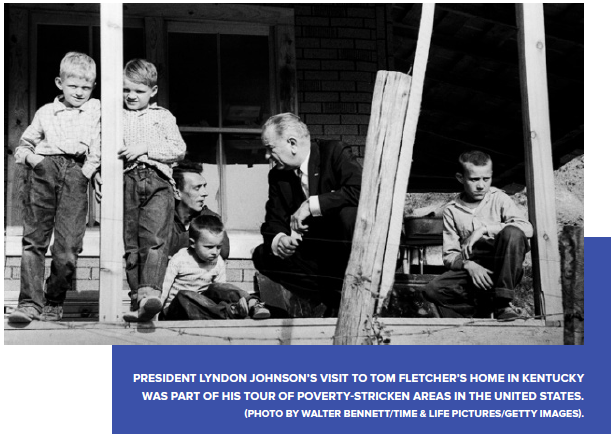
The “black ghetto” became a metaphor for criminality, idle youth, teenage pregnancy, out-of-wedlock babies, and welfare.
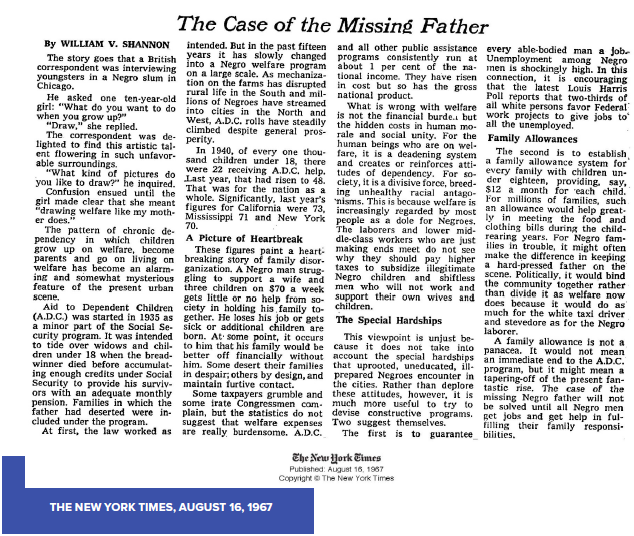
THE “UNDERCLASS,” THE “CULTURE OF POVERTY,” AND “BLACK FAMILY DYSFUNCTION”
Beginning in the mid-1970s journalists, academics, and other influential voices introduced and popularized concepts that became the received wisdom when it came to the causes of poverty in the United States. Each of them set poor African American urban dwellers apart from the rest of society. In August 1977, Time published a cover story entitled, “Minority Within a Minority: The Underclass.” It began:
Behind the [ghetto’s] crumbling walls lives a large group of people who are more intractable, more socially alien and more hostile than almost anyone had imagined. They are the unreachables; the American underclass.
From this underclass, the article went on to say, came “a highly disproportionate number of the nation’s juvenile delinquents, school dropouts, drug addicts and welfare mothers, and much of the adult crime, family disruption, urban decay, and demand for social expenditures.” (Emphases added) Time’s formulation rapidly morphed into “permanent underclass” and “black underclass” and remained a staple in the mass media throughout the 1980s and 1990s. A 1986 U.S. News and World Report cover story, “A Nation Apart,” portrayed poor people of color in America’s inner cities as “a second nation…outside the economic mainstream—a separate culture of have-nots drifting further apart from the basic values of the haves.” That same year journalism professor Nicholas Lemann authored two widely read articles in The Atlantic in which he posited that the rise in out-of-wedlock births was “by far the greatest contributor to the perpetuation of the misery of ghetto life.” A year later, a prominent article in Fortune defined “underclass communities” as “urban knots that threaten to become enclaves of permanent poverty and vice.” Their “behavior—their chronic lawlessness, drug use, out-of-wedlock birth, non-work, welfare dependence, and school failure” defined the “underclass” which was “at least as much a cultural as an economic condition.”[5] (Emphasis added)
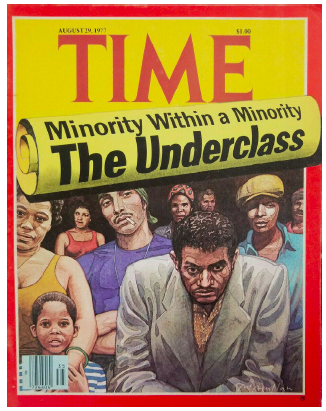
The idea that there was a “culture of poverty” gained currency during this period. This was not a new concept. Anthropologist Oscar Lewis introduced it in his 1961 award-winning book, The Children of Sanchez, a field study that was heralded as a “watershed achievement in the study of poverty.” He followed up that book with another, La Vida: A Puerto Rican Family in the Culture of Poverty, and an influential article in Scientific American entitled simply, “The Culture of Poverty.” According to Lewis, this culture was characterized by “the lack of effective participation and integration of the poor in the major institutions of the larger society,” a distinctive family life characterized by early initiation into sexual activity and a high incidence of abandonment of wives and children, and feelings of “marginality or helplessness, of dependence, and of inferiority.” Lewis has always maintained that his intention was not to perpetuate stereotypes or justify prejudices, but rather to shed light on intractable poverty so that conditions could be improved. Nevertheless, by the 1970s the “culture of poverty” had become a conservative concept used to further conservative social welfare policies.
Out of the urban underclass and the culture of poverty came an additional racist trope: the dysfunctional black family. In 1965 Daniel Patrick Moynihan was an assistant secretary of labor in the Johnson Administration and a supporter of the War on Poverty. Drawing on the work of black sociologists E. Franklin Frazier and Kenneth Clark, his confidential report, “The Negro Family: The Case for National Action,” also known as the “Moynihan Report,” described a “cycle of poverty” and a “tangle of pathology,” which were fundamentally problems of family structure. Most troubling was the fact that “almost one-fourth of Negro families are headed by females, forcing Negro families into a ‘matriarchal structure’” and, as a consequence, a “startling increase in welfare dependency.” Based on the available evidence, he wrote, “[T]he Negro family in the urban ghettos is crumbling…. So long as this situation persists, the cycle of poverty and disadvantage will continue to repeat itself.”
The Moynihan Report was intended “For Official Use Only,” but it was leaked to the media and picked up by the widely syndicated conservative newspaper columnists Rowland Evans and Robert Novak, who wrote that Moynihan’s document had exposed “the breakdown of the Negro family,” with its high rates of “broken homes, illegitimacy, and female-oriented homes.” The Wall Street Journal and National Review also embraced the report. Ignoring Moynihan’s call for massive federal intervention in the labor market, they highlighted his sections on the “dysfunctional black family” to support their narrative’s emphasis on personal responsibility over government intervention.[6] The report became a string to the conservative movement’s bow.
THE RISE OF THE CONSERVATIVE NARRATIVE
During the 1960s the American conservative movement was in disarray. The stunning defeat of Barry Goldwater and his vision of small government and laissez-faire economics was a major setback for the movement. Days after the election, a small group of conservative intellectuals, including William F. Buckley, Jr., met and decided to form the American Conservative Union. One of their chief objectives was to discredit the War on Poverty. The conservative movement viewed the War on Poverty as a threat to its social philosophy based on personal responsibility; individualism; and a laissez-faire, free market economy. According to its adherents, programs for the poor might be a necessary evil at times, but they should be kept as small as possible. To challenge the War on Poverty and the values it stood for, they needed to construct a narrative that both discredited the social and economic policies enacted under its mantle and stigmatized the recipients of its programs. The tumultuous events of the late-1960s and ’70s set the stage for narrative shift.
This narrative began to be built toward racializing public assistance, and that was the key point of the transition. It was part of the tumultuous 1960s and it was fought really intensely by not just the think tanks, but by the corporations who were beginning to think that they were losing the battle big time, especially when the social programs of the Great Society came in. That’s when the alliance or fusion between the corporations and the think tanks and the conservative movement and funders, the four billionaires—John Olin, Richard Mellon Scaife, and the Koch brothers—took place.
The conservative narrative received a considerable lift from the state of the American economy during the mid-1970s. The fiscal crisis that drove New York City to the brink of bankruptcy was characterized by low economic growth, high unemployment, inflation, and a dramatic increase in AFDC rolls nationwide. All these factors lent support to the conservative narrative that blamed federal programs for concentrated urban poverty and economic decline. Their argument that the “welfare state” was bankrupting the country gained traction with the public.
The conservative movement was able to catalyze a backlash against the War on Poverty by tapping into this growing antipathy and anxiety and emphasizing a distinction between the “deserving” and “undeserving” poor. A consistent majority of Americans over time have believed that it is the responsibility of the government “to take care of people who can’t take care of themselves,” the “truly needy.” But the same sentiment does not extend to those viewed as “lazy” and capable but unwilling to work and seeking “hand-outs.” For more than 40 years, public opinion researchers have been asking the following question: “In your opinion, which is generally more often to blame if a person is poor—lack of effort on their own part or circumstances beyond their control?” The results expose the continuing tug of war between the belief in personal responsibility and the awareness of structural barriers to opportunity, and different policy preferences flow depending on which explanation is in ascendance at any given time. The following two figures show a correlation between responses to the question and the unemployment rate: When the unemployment rate is high, more people choose “circumstances beyond their control” as the reason a person is poor.
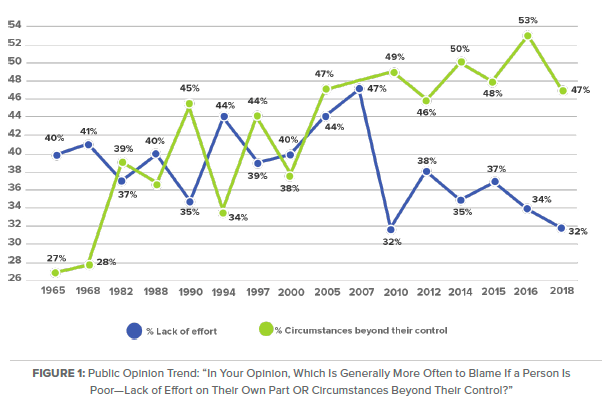
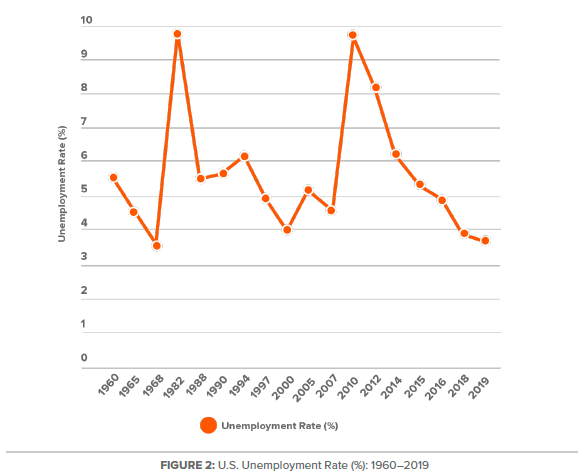
Conservatives put serious resources into their narrative shift project. In his authoritative book, The Undeserving Poor, historian Michael B. Katz describes how the movement created a network of think tanks, including the American Enterprise Institute, The Heritage Foundation, and the Manhattan Institute, “designed to counter liberalism, disseminate conservative ideas, and promote conservative public policy.” Within a year of its founding in 1973, for example, The Heritage Foundation received grants from 87 corporations and several major foundations. Heritage and other conservative grantees published a steady stream of books and articles criticizing federal anti-poverty programs, and they invested in the aggressive marketing of their ideas. A 1997 report from The National Committee for Responsive Philanthropy titled, “Moving a Public Policy Agenda: The Strategic Philanthropy of Conservative Foundations,” observed that one of the factors accounting for the think tanks’ effectiveness in influencing public opinion was as follows:
The foundations have invested heavily in institutions and projects geared toward the marketing of conservative policy ideas. Through the provision of both general operating and project specific support, these funders have enabled policy institutions to develop aggressive marketing campaigns, media outreach efforts, and new communications tools with which to build their constituency base, mobilize public opinion and network with other organizations around a common reform agenda.
Government social welfare spending was in the crosshairs from the start. In 1984 the Manhattan Institute sponsored two books that argued for the elimination of federal anti-poverty programs: Wealth and Poverty by businessman and author George Gilder and Losing Ground: American Social Policy, 1950–1980 by Charles Murray, a political scientist. Gilder’s book contended that poverty was the twin result of the lack of personal responsibility and government programs that rewarded and encouraged it. Murray’s most provocative argument was that the anti-poverty programs launched by the War on Poverty were themselves responsible for continuing poverty because they discouraged work effort and promoted idleness. He called for “scrapping the entire federal welfare and income-support structure for working-aged persons, including Aid to Families with Dependent Children, Medicaid, Food Stamps, Unemployment Insurance, Worker’s Compensation, subsidized housing, disability insurance and the rest.” With copious graphs and charts, Murray argued that the condition of black families in particular worsened during the 1960s; while poverty rates declined, illegitimacy, welfare dependency, and youth unemployment increased, leaving the “black underclass” behind.
The Manhattan Institute sent 700 free copies of Murray’s book to influential politicians, academics, and journalists and paid for a public relations specialist to manage the “Murray Campaign.” The Institute held a seminar featuring Murray and paid participants honoraria to attend. The book was a media sensation and it set off a public debate between defenders and detractors of the War on Poverty. Losing Ground was followed by another very influential book, Beyond Entitlement: The Social Obligations of Citizenship by Lawrence Mead, a conservative political scientist. Published in 1986, Mead’s book picked up Murray’s argument and promoted the idea that welfare recipients be required to work. These books, along with a flood of materials published and distributed by conservative and libertarian think tanks, created the intellectual framework for an attack on federal anti-poverty programs in particular and “big government” in general.

Conservative think tanks featured heavily in news media coverage of poverty, with The Heritage Foundation, American Enterprise Institute, and Manhattan Institute quoted in more than 11,000 mainstream news media articles since the late 1970s. At the core of the conservative narrative was the idea that poverty was the lot of people whose culture and behavior kept them at the bottom of society and that the “perverse incentives” of the welfare system only encouraged and deepened their misery. Conservative opinionmakers wrote and talked about “disturbing symptoms of social pathology such as crime and broken homes.” Typical of this underclass discourse was a column by neoconservative Irving Kristol that appeared in the Wall Street Journal. In this piece, entitled “The Poverty of Equality,” he wrote:
In New York we have tried to abolish poverty through a generous welfare program, and while statistically lifted out of poverty, the city’s poor have simultaneously sunk to various depths of social pathology. Welfare has produced a largely demoralized population, with higher rates of crime, juvenile delinquency, drug addiction, teenage pregnancy, alcoholism, and other disastrous behaviors.
These were the “undeserving poor.”
RONALD REAGAN POPULARIZES THE CONSERVATIVE NARRATIVE
Among the many conservative leaders who embraced the theses of Murray, Mead, and others was Ronald Reagan. Reagan’s opposition to social spending in general, and welfare in particular, was well known. In his 1970 California gubernatorial campaign Reagan called welfare a “costly and tragic failure” that was “destroying people, our most precious resource, by creating a permanent and growing poverty class.” During his 1976 failed candidacy for president, Reagan introduced audiences to the “welfare queen” at every campaign stop:
There’s a woman in Chicago. She has 80 names, 30 addresses, 12 Social Security cards and is collecting veterans’ benefits on four non-existing deceased husbands. And she’s collecting Social Security on her cards. She’s got Medicaid, getting food stamps and she is collecting welfare under each of her names. Her tax-free cash income alone is over $150,000.
Attacking “welfare chiselers” was also an integral part of Reagan’s stump speech, and it resonated with voters.
As a politician, Ronald Reagan was known for his anecdotal style of speech-making and none was stickier than his story about the welfare queen.[7] As Mark Shields put it in his post-election column in the Washington Post on November 27, 1981:
More than any other modern American politician, Ronald Reagan has employed the graphic anecdote as a devastating campaign weapon. A listener could almost see the notorious Welfare Queen in her designer jeans and Mercedes Benz as candidate Reagan described her collecting nearly as much in AFDC payments as Mobil was willing to pay for Marathon Oil….The anecdotes were basic to the challenger’s basic speech, and the challenger won.
Hundreds of references to the “welfare queen” appeared in media reports about welfare fraud during the early 1980s, and the belief that “welfare cheats” and “deadbeat dads” were robbing the taxpayers gained ground. Again, this established a dynamic of racism and assumption around the profile of the “welfare queen” and the “deadbeat dad,” a set of stereotypes that have endured into modern times through cultural memes and other dominant frames.
Reagan also popularized the notion that welfare was responsible for “intergenerational poverty” and the “breakdown of the family.” In a weekly radio address in 1986 he noted that the number of illegitimate births had doubled since 1960 and that many of the mothers were teenagers. “In inner cities today,” he said, “families as we’ve thought of them are not even being formed…. [I]n some instances, you have to go back three generations before you can find an intact family… Government programs have ruptured the bonds that held families together.” This was powerful rhetoric. Reagan is justly credited with popularizing the conservative narrative that undermined support for the War on Poverty and social spending on the poor in general.
The choice of language and terminology is key in the framing and promotion of a narrative. The field of cognitive linguistics tells us that people form their views about issues based more on their values than on the facts alone. Using language that evoked the shared American value of “personal responsibility” combined with implicit appeals to racism made Reagan’s messages extremely potent. The effectiveness of Reagan’s vilification—and implied criminalization—of people who received welfare is revealed in news media data. The term “welfare queen” began to emerge in mainstream media coverage in the early 1970s. As a result of Reagan’s stump speech during the 1976 presidential campaign, references to “welfare queen” in news media began to climb, almost doubling between 1980 and 1981 when Reagan took office.[8]
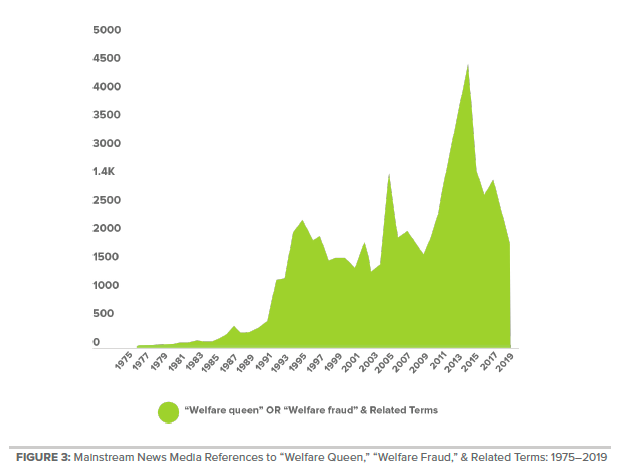
Upon his election, President Reagan moved quickly to curb welfare spending. The Omnibus Budget Reconciliation Act of 1981 cut the welfare rolls by 400,000 individuals and reduced benefits for hundreds of thousands more. Federal spending on food stamps was also reduced. In his 1985 State of the Union address at the beginning of his second term, Reagan echoed the conservative narrative when he said, “Policies that increase dependency, break up families and destroy self-responsibility are not progressive…” By the late 1980s, the idea that poor people were too dependent on welfare had gone way beyond its conservative origins and had become mainstream. By 1992, 79 percent of the American public agreed with the statement, “Poor people have become too dependent on government assistance programs,” and “personal responsibility” was the catchphrase of the day.
When Reagan came into office The Heritage Foundation published something called Mandate for Leadership. Mandate for Leadership took every independent agency and federal department and proposed a right-wing agenda for them. It was a 1,000-page document. Heritage provided the blueprint and they provided the transition and the leadership. They parachuted in ideological activists at the beginning of the Administration—kind of like Sherpa teams or like Special Forces teams—to transform the agencies from within and undermine the Great Society programs.
“WELFARE REFORM”
Talk of reforming welfare had been abuzz well before Bill Clinton made it a centerpiece of his 1992 presidential campaign. All through the 1970s and 1980s, support grew for “workfare”—the requirement that able-bodied recipients “work off” their welfare checks. As far back as 1967 the federal government had instituted the Work Incentive Program (WIN), but in its first 20 months, only 10 percent of the cases referred for work were considered employable. This was also the experience of the bipartisan Family Support Act of 1988, which directed all the states to phase in comprehensive welfare-to-work programs by 1990. The initiative was unsuccessful, however, because states lacked the money needed for matching funds to implement education, job training, and job placement programs.
By the time of the 1992 general election campaign there was all but universal agreement that the AFDC program was broken, and Gov. Clinton’s promise to “end welfare as we know it” and the companion phrase “Two years and you’re off” had great popular appeal. As president, Clinton’s first reform proposal would have required younger welfare recipients to go to work after 2 years, but in return it guaranteed low-paid public sector or government subsidized jobs. It also provided that those who “played by the rules” but couldn’t find work could continue to receive benefits within the same needs-based framework that had existed since 1935. But the Republican sweep of Congress in the 1994 midterm elections killed any possibility that the Clinton reform bill would pass. That year, the conservative narrative achieved its goal to devalue a narrative of compassion, empowerment, and entitlement and replace it with one celebrating and emphasizing personal and individual responsibility. Henceforth that narrative would dominate the debate and would lead to a more radical reform than Clinton had originally contemplated.
Six weeks before the midterm elections, the House Republicans, then in the minority, released their 10-point “Contract with America,” which identified their legislative priorities for the first 100 days of the 104th Congress. Third on the list was the “Personal Responsibility Act”:
Discourage illegitimacy and teen pregnancy by prohibiting welfare to minor mothers and denying increased AFDC for additional children while on welfare, cut spending for welfare programs, and enact a tough two-years-and-out provision with work requirements to promote individual responsibility.
The Republicans were banking on the electorate’s overwhelming dislike of welfare and its acceptance of the conservative narrative. By 1994, 72 percent of the public said the system of public assistance did not work well, and 73 percent believed it discouraged people from working. Seventy-one percent believed the welfare system did more harm than good “because it encourages the breakup of the family and discourages the work ethic.”
Congressional Democrats lambasted the Personal Responsibility Act, warning that it would send more than 1 million children into poverty. Sen. Edward Kennedy of Massachusetts called it “legislative child abuse,” and President Clinton vetoed two versions passed by Congress. As the 1996 presidential election loomed, Clinton’s promise to “end welfare as we know it” was still unfulfilled, and he signaled that he would sign a Senate bill that was less draconian than the House version.
Beltway pressure was building to do something, and on August 12, The New Republic published its notorious cover story urging Clinton to sign the welfare bill. It featured a picture of a black woman cradling an infant while smoking a cigarette with the words “Day of Reckoning” splashed above. The editorial inside labeled welfare “America’s gravest problem” and tapped into the racial resentment that drove much of the debate. On August 22, just months before the November election, Clinton signed the Personal Responsibility and Work Opportunity Reconciliation Act. The new legislation replaced AFDC with TANF (Temporary Assistance for Needy Families) and provided block grants to the states. Lifetime benefits were limited to a maximum of 5 years, although states could set lower limits. Families had to make “verifiable efforts to leave welfare for work” and to “avoid births outside marriage.” A poll taken at the time showed that 82 percent of the public approved of the Act.

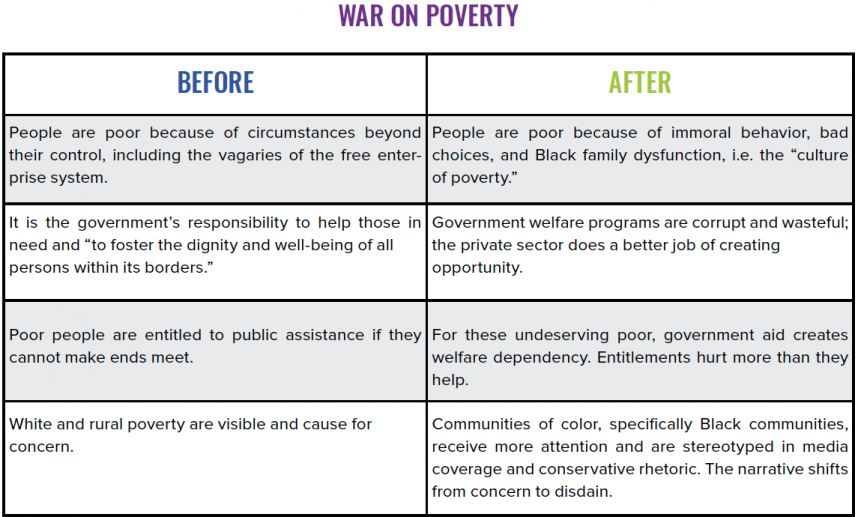
CONCLUSION
The fiftieth anniversary of the War on Poverty in 2014 brought forth a spate of articles and reports, some celebrating its accomplishments and others condemning its failures. President Obama said the programs it created “lived up to our best hopes as a people who value the dignity and potential of every human being.” The Heritage Foundation called it “Fifty Years of Failure.” But there is little doubt that the conservative movement was successful in popularizing a narrative that is still resonant with many Americans and that continues to pose a major obstacle to the passage of progressive social welfare policies. As Rebecca Vallas, head of the Poverty to Prosperity Program of the Center for American Progress, explains:
I think that generally when you use the word poverty most people’s minds are still going to the image shaped by the Reagan-era welfare queen. I think it’s still infused with race; I think it’s still likely to be a person of color that someone imagines. I think it’s still likely to be someone who is experiencing homelessness. And so I think that the dominant narrative about poverty continues to be that somebody who is not working and is facing some level of visible destitution. I do think that because of the success of the Fight for $15 movement and the debate over minimum wage that we are moving in a direction where the binary between the ‘deserving’ and the ‘undeserving’ is starting to break down and people are starting to appreciate that poverty is the result of an economy that isn’t working for everyone. But we have a lot more work to do to truly get to a place where someone’s brain immediately goes to poverty being a matter of policy choices rather than a matter of a person’s individual ‘bad choices.’
It is also the case that a powerful counternarrative is gradually taking hold in America that emphasizes the extreme economic inequality that defines the nation today. Beginning with the Occupy Wall Street movement following the 2008 economic crisis and evident in the strength and breadth of Bernie Sanders’s campaigns for president during which he popularized social democratic values, more Americans, especially younger Americans, are hewing to a structural explanation for poverty and a belief in a positive role of government. A Pew Research Center survey of members of Generation Z (born between 1997 and 2012) found that they are more likely than older generations to look to government, rather than businesses and individuals, to solve problems. Fully seven-in-10 Gen Zers say the government should do more to solve problems.[9] The COVID-19 pandemic and its economic aftermath are sure to sharpen this fundamental debate.
1 In the introduction to The War on Poverty; A New Grassroots History, 1964–1980 (Eds. Annelise Orleck and Lisa Gayle Hazirjian) the editors capture the energy of the early War on Poverty: “In decaying, inner-city neighborhoods, Rust Belt towns, backwoods hollows, and Indian reservations, grassroots activists, elected officials, and social welfare professionals feverishly conceived and submitted proposals to the OEO for ‘community action’ projects. Channeling federal stipends and grants, poor men and women rehabilitated abandoned buildings and opened clinics, preschools, and community centers. Residents cleaned up neighborhood parks, planted community gardens, and renovated and reopened public swimming pools. They published community newspapers, chased drug dealers out of neighborhoods, and kept them away with resident-run anticrime patrols.”
2 The Kerner Commission, officially named the National Advisory Commission on Civil Disorders, was appointed by President Johnson and chaired by Otto Kerner, governor of Illinois. It held public hearings throughout the country and released its comprehensive report in 1968.
3 For a historical description of how the term “ghetto” was first appropriated by African Americans to describe segregated housing and then became a pejorative racial term see Daniel B. Schwartz, “How America’s Ugly History of Segregation Changed the Meaning of the Word ‘Ghetto’” at https://time.com/5684505/ghetto-word-history/
4 Martin Gilens, Why Americans Hate Welfare: Race, Media, and the Politics of Antipoverty Policy, University of Chicago Press, 2009.
5 These articles are cited in The Undeserving Poor by Michael B. Katz, who also describes the debate over the term “the underclass” between social scientists on the left and the right.
6 The report quickly generated tremendous controversy. At the time it was criticized by civil rights leaders and supporters for blaming the victim and painting an overly negative picture of black culture. Criticism by black public figures was not universal. Sociologists Kenneth Clark and William Julius Wilson, for example, praised the report.
7 In his 2019 book, The Queen, Josh Levin shows that the “queen,” Linda Taylor, was in fact a con artist and in no way representative of AFDC recipients of that era.
8 References to “welfare queen” and other negative terms began to spike dramatically in the early 1990s and again beginning in the mid-2000s. It remains a trope referenced in media coverage of poverty, with just under 12,000 articles published between 2015 and 2019 making reference to the term or the concept of welfare fraud and dependence.



